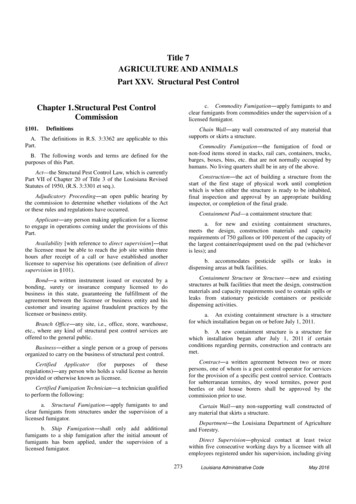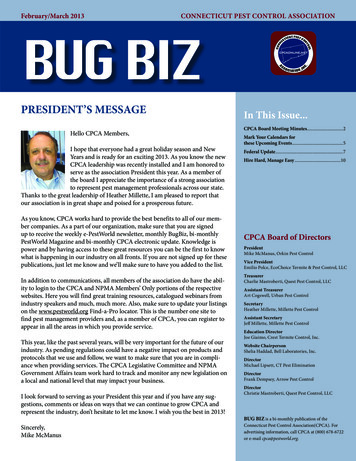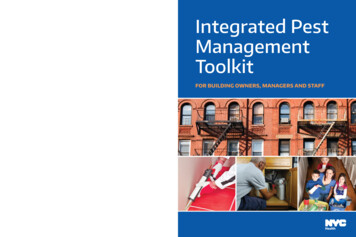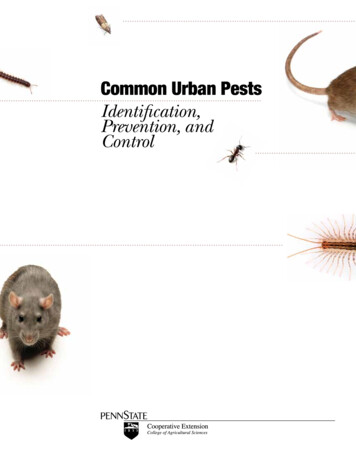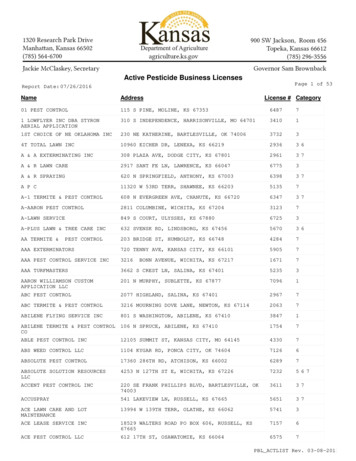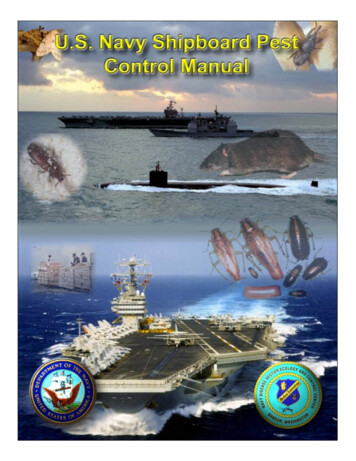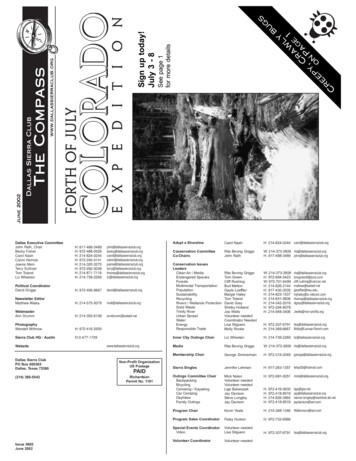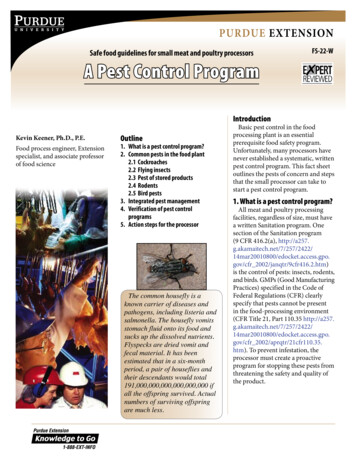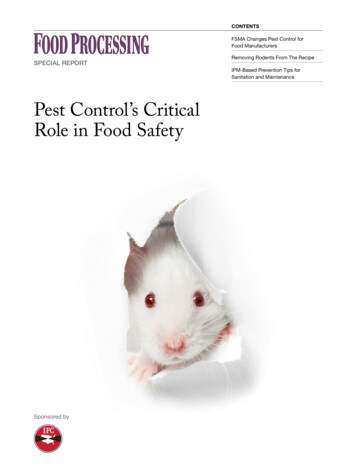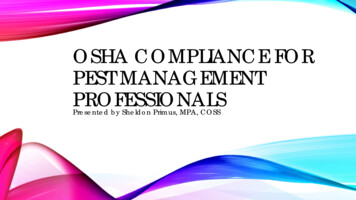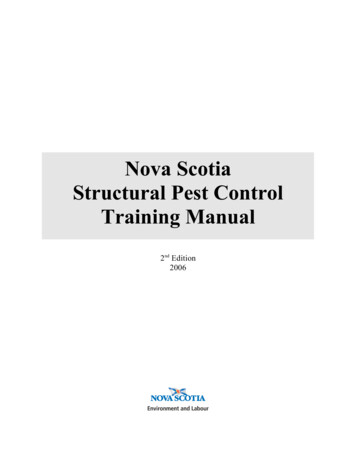
Transcription
Nova ScotiaStructural Pest ControlTraining Manual2nd Edition2006
NoticeThis manual is provided for information only. Users of this manual rely on the contents of thismanual at their own risk. This manual is not intended to be a representation of the current law onthe subject of pesticide use. Users of this manual should always check with the appropriateauthorities in their area to ensure Users are conducting their activities in a proper manner and inaccordance with the laws of their jurisdiction. The Government of Nova Scotia, as represented bythe Department of Environment and Labour, is in no way responsible for the activities of Users ofthis manual.
AcknowledgmentsThe Nova Scotia Department of Environment and Labour would like to acknowledge thecontribution of the University of Nebraska Lincoln Extension. Some of the material contained inChapters 2,3, 4, 9, 14, 16, 17, 19 and 20 has been adapted from Structural & Health Related PestControl with permission from Larry Schulze, Pesticide Education Specialist, University of NebraskaLincoln ExtensionAcknowledgments for the First EditionThe New Brunswick Department of the Environment and the Nova Scotia Department of theEnvironment would like to acknowledge the contribution of the United States EnvironmentalProtection Agency. Much of the content of this manual is derived, with permission, from the "UrbanIntegrated Pest Management - A Guide for Commercial Applicators" manual developed by Dr.Eugene Wood and Lawrence Pinto for the UnitedStates Environmental Protection Agency.Special thanks is extended to Normand Doiron and John Robichaud for their input and review of thismanual. As well, the New Brunswick and Nova Scotia Departments of the Environment would liketo acknowledge the contributions made by the National Task Force on Pesticide Education,Certification and Training in the development of the standards from which this manual evolved.This manual is a joint effort between the provinces of New Brunswick and Nova Scotia. Funding forthe development of this manual was provided by the New Brunswick Environmental Trust Fund andthe province of Nova Scotia.
IntroductionStructural pest control refers to the control of pests in, on or near a structure. A structural pest controlapplicator must be able to identify, and know the basic life history, habitat and damage of structuralpests. From this information, the applicator must be able to deter-mine a method of control, and ifthat method of control involves the use of pesticides, the applicator must ensure that pesticides areused safely and effectively.This manual, the Structural Pest Control Pesticide Safety Manual, in conjunction with the ApplicatorCore Training Manual, contains the minimum amount of information that all structural pest controlapplicators must know in order to become a certified pesticide applicator.The Structural Pest Control Pesticide Safety Manual focuses on information specific to structuralpest control. Detailed information is presented on major pests as well as application equipmentutilized by structural pest control applicators. Applicators wishing to obtain a Pesticide Applicator'sCertificate for structural pest control must be aware of the information contained within bothmanuals in order to pass an examination.Both the Applicator Core Training Manual and this manual have been set up to help you prepare forthe structural pest control applicator certification exam. Read the learning objectives box at thebeginning of each chapter. This will allow you to recognize the most important points from eachchapter. Read each chapter carefully and answer the questions at the end. The answers to thequestions ca nbe found in an appendix at the end of the manuals. This section is to help you obtainand understand the correct answers. These learning objectives, questions, and answers have beendesigned to help you learn the most important points from each chapter.NOTE: Information pertaining to fumigation is not covered in this training manual. In Nova Scotia,the use of fumigant gasses is not covered by a Structural Pesticide Applicator’s Certification.For additional information on pesticide certification, please contact:Nova Scotia Department of Environment and LabourP.O. Box 697Halifax, N.S.B3J 2T8Tel: 902-424-5300Copies of this manual are available on line at:www.gov.ns.ca/enla/pests/applicator.asp
TABLE OF CONTENTSCHAPTER 1: Legislation .1.1CHAPTER 2: Integrated Pest Management .2.1CHAPTER 3: Ants.3.1CHAPTER 4: Bed Bugs.4.1CHAPTER 5: Bees and Wasps .5.1CHAPTER 6: Cockroaches.6.1CHAPTER 7: Fabric Pests.7.1CHAPTER 8: Fleas.8.1CHAPTER 9: Domestic Non-biting Flies.9.1CHAPTER 10: Occasional Invaders.10.1CHAPTER 11: Paper Pests.11.1CHAPTER 12: Spiders .12.1CHAPTER 13: Stored Product Pests .13.1CHAPTER 14: Ticks .14.1CHAPTER 15: Vertebrate Pests .15.1CHAPTER 16: Birds.16.1CHAPTER 17: Rodents .17.1CHAPTER 18: Wood Destroying Insects.18.1CHAPTER 19: Structural .19.1CHAPTER 20: Pesticide Safety.20.1APPENDIX A: Answers to Self-Test Questions .iAPPENDIX B: Provincial Legislation. viiiStructural Manual TABLE OF CONTENTS
TABLE OF CONTENTS
Chapter1LegislationPesticides are regulated in Nova Scotia under the authority of the Environment Act and the PesticideRegulations, administered by the Nova Scotia Department of the Environment and Labour. Theintent of the legislation is to ensure that pesticides are used, stored and disposed of in an appropriatemanner.Every citizen has a responsibility under the Act to ensure that their use of pesticides does not resultin pollution of the environment.It is important that structural pest control applicators have a clear understanding of provinciallegislation. Nova Scotia provincial pesticide legislation can be viewed on line al Manual1.1
Business Operator's CertificateAny business that sells the service of applying commercial or restricted class pesticides mustobtain a Business Operator's Certificate from the Nova Scotia Department of Environment andLabour. A completed Contingency Plan must be submitted along with the application for aBusiness Operators Certificate. The Business is responsible to maintain records of pesticidesuse. These records are subject to audit by NSEL.The Business Operators Certificate is valid for no more than one year from the date of issue andexpires on December 31. Specific terms and conditions are attached to the Business OperatorsCertificate. These terms and conditions are a legal document, enforceable under the EnvironmentAct. It is the responsibility of the Business Operator to ensure that these terms and conditionsare followed.Structural pesticide applicators should be familiar with the Terms and Conditions of the BusinessOperators and the businesses Contingency Plan. These documents must be reviewed at thebeginning of each season.Pesticide Applicator CertificationAll employees of the business who apply commercial or restricted class pesticides must becertified by the Nova Scotia Environment and Labour. Pesticide applicators must pass aprovincial pesticide applicator certification exam to become certified. This certificationauthorizes the applicator to use a pesticide, other than a herbicide or fumigant for theprevention or control of pests in or around a structure.Study material for the certification exam is contained in two manuals. They are the ApplicatorCore Training Manual and the Nova Scotia Structural Pest Control Training Manual . TheApplicator Core Training Manual contains the general knowledge that all users of pesticidesmust know and forms the core for all pesticide applicator programs. The Nova Scotia StructuralPest Control Training Manual contains specific information on pest management, applicationtechnology, legislation and safety procedures for the structural category.NOTE: In Nova Scotia, the use of fumigant gasses is not covered by a Structural PesticideApplicator’s Certification. Applicators wishing to use fumigant gasses must obtain certification inthe fumigation category.Permits and ApprovalsAdditional permits and/or approvals are required for pesticide application in certain situations.For additional information see the Activities Designation Regulations - Division II which can befound on-line at ructural Manual1.2
A permit from the Department of Natural Resources is required prior to conducting any bird orwildlife control program.Some municipalities may have restrictions on the use of pest control products. Applicatorsshould check with their local municipalities for further details.A Note on Pesticide labelsThe Pesticide label is a legal document. It is illegal to use a pesticide in any way other than forthe purpose and in the manner stated on the label.Pesticides used in structural pest management must be specifically registered for use in, on, oraround structures. These products can only be applied in the types locations specified on thelabel. Labels may also include statements to “keep out of areas accessible to children and pets”or “place in tamper resistant bait stations”.A registered pesticide can only be used in meat packaging or food processing plants if it contains acautionary statement specific to these two use locations, and it must also be included in theReference Listing of the Canadian Food Inspection Agency (CFIA).Structural Manual1.3
Self-test QuestionsAnswers are located in Appendix A of this manual.1.What is the name of the regulation that covers the use of pesticides in Nova Scotia ?2.Pesticide applicators who have a Structural Pesticide Applicator Certification may usefumigant gasses. True or False3.A certified structural pesticide applicator may require an additional permit to conduct whattype of pest control operation ?Structural Manual1.4
Chapter2Integrated Pest ManagementIntegrated Pest Management (IPM), is not a new approach in structural pest management. Infact, IPM has been practised in structural pest management for many years.IPM is a process that considers all available information and control methods when managingpest populations. When using an IPM approach, pest populations are maintained beloweconomically damaging or socially unacceptable levels. All practical measures to suppress thepest population to a tolerable level are considered: These include cultural controls (e.g., changesin maintenance practices, regular cleaning schedule, garbage elimination, changes in workerprocedures) pest exclusion and physical modifications (e.g., screening, caulking, etc.) and pestcontrol devices and pesticides Using a combination of these cultural, physical, biological andchemical control techniques to minimize adverse effects to the public or the environment.The Applicator Core Training Manual has an entire chapter devoted to the topic of IPM. Makesure you are thoroughly familiar with the techniques involved in IPM.Learning ObjectivesCompleting this chapter w ill help you to: Understand the concept of Integrated Pest Management. Be familiar with the components of an IPM program.Structural Manual2.1
Structural IPM programs differ from IPM programs in other pest management industries in fourmain ways: Prevention of pest infestations is very effective and should be the main objective o f thepest management program; Unlike out door pests, eradication of certain structure invading pests with a specific area(such as a warehouse or food processing plant ) is a realistic goal because the pests areinside specific boundaries; A working knowledge of building design especially plumbing, electrical and ventilationsystems is essential; Communication with clients is particularly important for establishing tolerances and foreducating clients about the IPM approach. Once a problem is under control, the applicatormust work with the clients to develop a long term preventative program.Putting IPM into PracticeWhen starting to implement IPM, it is often best to set realistic objectives for a small site or for afew types of pests before using IPM on a large scale. Before beginning an IPM program, it isimportant to collect and analyze information about a management site, including: physical characteristics of the building or structure,environmental and human health protection concerns including an inventory of areas thatrequire protection,building use patterns,records of past pest problems and treatments that were used,maintenance practices, preventive measures and treatments that could be used,financial and other resources available to implement the IPM program,regulatory requirements or bylaws that apply,When developing an starting an IPM program for a client site , a plan should be developed thatincludes all IPM components. The basic components of an IPM plan include: education of pest management technicians,site inspection and identification of all pest problems (including numbers of pestspresent) and possible contributing factors,client education,pest prevention including exclusion (e.g., caulking, screening, pallet management etc.)and sanitation (e.g., cleaning, waste management, cardboard box management) habitatalteration (e.g., open doors, windows, landscaping and lighting that promotes pestproblems),selection of thresholds and suitable monitoring methods,selection and use of control measures (e.g, clean out trapping, pesticide application etc.)establishing a record keeping system and quality assurance program,Structural Manual2.2
program evaluation (usually done once a year),regular communication with client or client representative,The following is a more detailed description of the IPM techniques listed above.ThresholdsPest management is site specific. The number of pests that can be tolerated in each target sitemust be determined. Setting thresholds, eliminates preventive spraying, curtails excessivepesticide application, and encourages good inspection.Inspection and MonitoringInspection of a structure involves searching for evidence of an infestation, such as actual pestsightings, droppings, cast insect skins, rodent hairs and damage. Pest harbourages, means of entryinto the structure, and sources of moisture, food and heat should also be examined. Obtaininginformation from people who live or work in the structure is a very important part of conductingan inspection. Pests do not infest uniformly; they focus on specific areas. These sites must belocated. Training and experience in conducting inspections are important for successful locationof infested areas.No area in a structure should be excluded from inspection. For example, make sure to note thelocation of pipes, ducts, cables, telephone lines and all other utility lines leading into thestructure. Make special notes on kitchen and bathroom areas. Pay close attention to the sanitaryconditions and general structural maintenance of these areas. Inspect the exterior of a structureby walking the entire area, noting the location of such things as trash containers, dumpsters,drains, air conditioners and planters. Note any areas where pests may enter the structure or wherethey maybe living outside.Tools required to perform a proper inspection include a flashlight, hand lens, hand tools,collecting vials, and sticky traps. A mechanic's mirror and stethoscope are also helpful in somesituations.A monitoring program involves trapping, sighting, and recording observations. Pests captured onsticky traps can be used to pinpoint areas and levels of infestations. Removing signs ofinfestation (e.g., droppings, nesting material and infested items), repairing pest damage, and thenchecking for re-occurrence may also be used to determine ongoing pest activity. A record ofmonitoring data should be maintained.Structural Manual2.3
Client Education and CommunicationGood communication between the pest control operator and the client is extremely important tothe success of the IPM program. Communication must be an ongoing activity involving training,education and a routine review of the goals of the pest control program.Control MethodsHabitat AlterationSince infested areas provide harborage for pests, changing or eliminating some of thesefavourable conditions will make the build up of pest populations less likely. Such changescommonly include , moisture reduction, elimination of clutter, pallet management, and changesto lighting and landscaping which promote pest problems.SanitationSanitation is a key component to the success of any IPM program. The structural pest controlapplicator must educate the client on the importance of maintaining a high level of cleanlinessboth inside and outside a structure. By maintaining a clean environment, pests may beeliminated. Sanitation practices may include routine and “special” cleaning, review andimprovement of waste management practices and management or packing materials such ascardboard boxes.ExclusionExclusion techniques involve methods that maintain an environment free from pests. Theselection of exclusion methods depends on the site and it’s intended use. Exclusion can includeapproaches such as caulking, screening, weather stripping and installing barriers (e.g.,porcupine wire) to reduce bird perching and loafing) to prevent pests from entering or usingstructures.Physical ControlPhysical control includes setting traps, glue boards or using other mechanical devices to reducepest populations. In some situations, physical control also involves the use of heat and cold tomanage pests. Physical control can also include nest removal using high pressure streams ofwater or manual methods (e.g., pole and hook).Structural Manual2.4
Chemical Control - PesticidesIn order to control certain pests, or in certain situations, the structural pest control applicatormust use a pesticide. A structural pest control applicator has more contact with the public thanother types of applicators. It is of the utmost importance that the applicator convey anddemonstrate a high degree of competency when applying pesticides. Failure to do so leaves thepublic with concerns about the risk of exposure to themselves, their family or coworkers, plus thepossibility of damage to the surroundings.The applicator must ensure: that the pest has been correctly identified,that an appropriate pesticide has been chosen to treat the pest,that the pesticide is registered to control the pest, taking into account the variety offormulations available, the surface to be treated, level of pest infestation, non-targetexposure and odour sensitivity.Application techniques (or treatments) used in structural pest control include the following: broadcast or generalspotcrack and crevicespacebaitBroadcast or general application refers to the application ofa pesticide to broad expanses ofsurfaces such as walls, floors, ceilings and foundations where pests are present.Spot applications refer to the limited application of a pesticide to a localized or specific area wherepests congregate.Crack and crevice applications refer to the application of small amounts of a pesticide directly into cracksor crevices, which may harbour pests.Space treatment refers to the application of a non-residual contact pesticide as a suspension of finedroplets in air within an enclosed space.A bait formulation is an active ingredient mixed with food or another attractive substance. The baiteither attracts the pest or is placed where the pest will find it. Baits are available as liquids or solidsand are placed in cracks, voids or other inaccessible areas.Evaluation and Follow-upFollow-up practices can make the difference between the success or failure to control pest problems.Follow up practices include detailed record keeping, supervisor oversight, a quality control program,and regularly scheduled client interviews and surveysStructural Manual2.5
A Note on Pesticide ResistanceRepeated applications of the same pesticide or chemically similar pesticides over time can lead to thebuild up of resistance. When this occurs the most complete application cannot achieve acceptablecontrol. With repeated applications after population recovery, the more succeptable individuals arekilled and those that are less susceptible become the parents of the next generation. Alternatingpesticides with different modes of action (e.g., organophosphates and pyrethriods) and of differenttypes (e.g., baits and IGRs) can also be helpful.Of the urban pests, the house fly and the German cockroach lead in the development of resistance topesticides. The use of an integrated approach to pest management reduces reliance on individualpesticides can help slow or prevent the development of resistant pest populations.Structural Manual2.6
Self-test QuestionsAnswers are located in Appendix A of this manual.1.What does the inspection of a structure entail?2.List tools required for an inspection ?3.What is involved in a monitoring program?4.Describe mechanical, physical and biological exclusion techniques ?5.Name five application techniques commonly used in structural pest control ?Structural Manual2.7
Structural Manual2.8
Chapter3AntsAnts are the dominant group of social insects. Except for the polar regions, they flourish on allland areas of the earth, from rain forests to deserts. All pest control applicators become involvedwith ant problems at some point in their career - most often because ants are found foraging ornesting inside structures.Learning ObjectivesCompleting this chapter will help you to: Be familiar with key features in the life cycle, habitat and appearance ofants.Know control methods for ants.The Ant ColonyAnts have a complex social structure consisting of workers (sterile wingless females), queens(reproductive females), males and larvae. Depending on the species, the workers may be furtherdivided into two or more specialized forms (e.g., soldiers) to preform specific tasks for thecolony. Body size and appearance may vary slightly between these forms depending on the taskthat they are doing.Most mature ant colonies produce winged males and winged reproductive females during theearly spring or summer.Structural Manual3.1
The winged reproductive female mates with a reproductive male either during the swarmingflight or on the ground. The male dies shortly afterwards. The female then digs or adapts a cavity,usually in the soil, and walls herself in to begin establishing a new colony. At this time, if herwings are not already broken off, she tears them off. She then produces eggs. The eggs hatch intotiny, white, legless grubs (larvae). The larvae are fed with salivary secretions from the female'sstored fat cells and the breakdown of her now useless wing muscles.After several molts, the larvae change into soft, white, pupae that look like motionless, whiteadults. When the pupae have made matured they molt into the adult stage. Adults take on one ofthe roles or castes of the community.Queens (reproductive females) may live for many years and produce eggs for the subsequentbroods that go on to make the colony. Worker (non-reproductive females) tend the eggs, larvae,and pupae, forage for food and enlarge and defend the colony.ForagingAnts eat a wide variety of food, including other insects, seeds, nectar, meats, fats, sugars, andhoneydew. Honey-dew is a liquid produced by plant sucking insects, such as aphids, mealy bugs,scale insects, and plant hoppers. These plant sucking insects feed in groups on plant stems andleaves where they may be protected by the ants who use the honey dew that they produce as afood source.Ants mainly locate their food by foraging at random. Their strong sense of smell is essential oncefood is in the immediate vicinity. Ant eyesight is thought to be extremely poor and of little use inlocating food. They forage by day or night depending on the species. Once a scout locates asource of food, she carries a piece of it back to the nest and alerts otherworkers. Many species laydown a pheromone chemical along the path from the food source to the nest. This providesworkers with an odour trail to follow to the food.Ant Control and ManagementCorrect identification of the ant species is necessary before a successful control program can beinitiated. The correct identification of an ant pest allows the applicator to determine whethertreatment is actually necessary.The successful control of any ant infestation is to locate all of the ant colonies in or around theproperty. The inspection is the most important step in dealing with ant infestations. It is critical totake the time to perform a thorough inspection and identify the areas where ants are active.Determine if the ant colony is located inside or outside the structure. Whether the colony is insideor out, ants known to tend honeydew producing insects often forage inside before plant insectpopulations can build up outside. After populations of aphids, mealybugs, scale insects, andwhiteflies become numerous in late spring, ant colonies nearby put a great deal of energy intoStructural Manual3.2
tending and protecting these plant sucking insects. Worker ants foraging inside kitchens and basements often leave the house at this time. They may return in dry weather seeking moisture, butoften will not be seen until the next spring. When pest control efforts coincide with this period, itis often difficult to tell whether the pest management procedure is effective, or whether the antsabandoned the structure due to natural habit.InspectionAs a professional applicator, it is very important to interview your client to get information aboutthe ant infestation. Observe ant worker movement and identify the focusof the infestation. Insidethe structure, inspect holes and cracks where workers enter, old or new moisture stains, fooddebris, activity near appliances, around bath tubs and showers, in drawers, and in adjoiningrooms. Outside the structure, inspect for workers behind vines, shrubs, other plants near thehouse, expansion joints, slabs, patio blocks, bricks, boards, plant pots, under and inside woodedcolumns and pillars, outside door and window frames, penetrations of the house wall bytelephone wires, air-conditioning refrigerant pipes, trees that harbour colonies and provide accessto houses by overhanging limbs that touch or even scratch shingles; water/electrical metres, andstorm drain inspection manholes. Inspect plants for ants tending aphids, mealybugs, etc.Control MethodsAn environmentally responsible ant management program involves correcting all conditionscontributing to the problem. These conditions must be corrected first. If insecticides are the onlymethod used to control the ants, then the program will ultimately fail and the ants will return.Before planning a control program talk to your clients and establish a threshold. Ants arebeneficial to the environment - clients should be encouraged to tolerate some ants especially inout door living areas, patios etc.Physical ControlAnts are like all pests, they require food, water, and shelter to survive; by denying them access toany or all of these, you can reduce or eliminate them. There are a number of "good housekeeping"practices to follow: Store food and food waste in containers with tight fitting lids to eliminate access by ants.Ants are foragers and will seek out food wastes. Ensuring the living spaces, office andstotage spaces are as free of food debris as possible.If ants are entering a structure through a crack seal it with silicone caulk.Use dusts in cracks, wall voids, and other hard to get areas before caulking.Structural Manual3.3
Habitat AlterationA thorough, long term ant management program involves correcting any conditions in and aroundthe structure that may be contributing to the infestation. It may be necessary to caulk wallpenetrations and mortar masonry cracks,
Structural Pest Control Training Manual 2nd Edition 2006. Notice This manual is provided for information only. Users of this manual rely on the contents of this manual at their own risk. This manual is not intended to be a representation of the current law on the subject of pesticide use. Users of this manual should always check with the .

